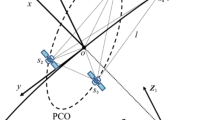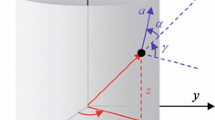Abstract
The dynamics and control of a tetrahedral spacecraft formation flying in the Sun-Earth L2 region is initiatively studied, based on the circular restricted three-body problem (CR3BP). Driven by the science goal of identifying extra-solar terrestrial planets and the requirement of imaging optics, a conceptional four-spacecraft triangular pyramid configuration has been proposed for the Multiple-spacecraft Exoplanet Aperture sYnthetic INterferometer (MEAYIN) project, China’s first mid-infrared interferometric imaging mission. Although it looked promising from an optical perspective, the configuration has not been verified dynamically. The formation is required to be virtually “rigid”, because its mutual distances and inertial pointing direction must be maintained with very high accuracy during each observation. In this study, the spatial geometrical relationship between the four spacecraft was established by introducing the parameters of lengths, angles, and a reference vector. The first contribution is that a compact set of normalized factors and critical time indices are defined, which can provide a complete description of the drift of the shape and pointing direction of the configuration, caused by the unstable dynamical environment. Five design variables are isolated and analyzed, and their individual impacts on the uncontrolled evolution of the formation are studied. The main results obtained reveal that the dimensions of the rigid configuration allow a free drift for a time period on the order of tens of hours, while the inertial pointing direction will be lost within merely tens of seconds. Therefore, to form a rigid configuration, the control challenge lies in the fact that control efforts are frequently required for each spacecraft in the fleet, owing to the diverging dynamics. As a second contribution, a simple and feasible control algorithm is proposed to maintain the rigidity of the formation configuration. The results indicate that the associated energy cost is merely 0.05 m/s per observation on average.

Similar content being viewed by others
Change history
11 February 2022
A Correction to this paper has been published: https://doi.org/10.1007/s42064-022-0136-2
References
Gómez, G., Lo, M., Masdemont, J., Museth, K. Simulation of formation flight near L2 for the TPF mission. In: Proceedings of the AAS Astrodynamics Specialist Conference, 2001: AAS 01-305.
Beichman, C., Gómez, G., Lo, M., Masdemont, J., Romans, L. Searching for life with the Terrestrial Planet Finder: Lagrange point options for a formation flying interferometer. Advances in Space Research, 2004, 34(3): 637–644.
Kaltenegger, L., Fridlund, M. The Darwin mission: Search for extra-solar planets. Advances in Space Research, 2005, 36(6): 1114–1122.
Xu, M., Liang, Y. Y., Ren, K. W. Survey on advances in orbital dynamics and control for libration point orbits. Progress in Aerospace Sciences, 2016, 82: 24–35.
Barden, B. T., Howell, K. C. Dynamical issues associated with relative configurations of multiple spacecraft near the Sun-Earth/Moon L1 point. In: Proceedings of the AAS/AIAA Astrodynamics Specialist Conference, 2000: AAS 99-450.
Scheeres, D., Vinh, N. Dynamics and control of relative motion in an unstable orbit. In: Proceedings of the Astrodynamics Specialist Conference, 2000: 2000–4135.
Gurfil, P., Kasdin, N. J. Stability and control of spacecraft formation flying in trajectories of the restricted three-body problem. Acta Astronautica, 2004, 54(6): 433–453.
Howell, K. C., Marchand, B. G. Natural and non-natural spacecraft formations near the L1 and L2 libration points in the Sun-Earth/Moon ephemeris system. Dynamical Systems, 2005, 20(1): 149–173.
Akiyama, Y., Bando, M., Hokamoto, S. Station-keeping and formation flying based on nonlinear output regulation theory. Acta Astronautica, 2018, 153: 289–296.
Wang, W., Mengali, G., Quarta, A. A., Baoyin, H. X. Decentralized fault-tolerant control for multiple electric sail relative motion at artificial Lagrange points. Aerospace Science and Technology, 2020, 103: 105904.
Gómez, G., Marcote, M., Masdemont, J. J., Mondelo, J. M. Zero relative radial acceleration cones and controlled motions suitable for formation flying. The Journal of the Astronautical Sciences, 2005, 53(4): 413–431.
Héritier, A., Howell, K. C. Dynamical evolution of natural formations in libration point orbits in a multi-body regime. Acta Astronautica, 2014, 102: 332–340.
Salazar, F. J. T., Masdemont, J. J., Gómez, G., Macao, E. E., Winter, O. C. Zero, minimum and maximum relative radial acceleration for planar formation flight dynamics near triangular libration points in the Earth-Moon system. Advances in Space Research, 2014, 54(9): 1838–1857.
Salazar, F. J. T., Winter, O. C., Macao, E. E., Masdemont, J. J., Gómez, G. Natural formations at the Earth-Moon triangular point in perturbed restricted problems. Advances in Space Research, 2015, 56(1): 144–162.
Salazar, F. J. T., Winter, O. C., Macao, E. E., Masdemont, J. J., Gómez, G. Zero drift regions and control strategies to keep satellite in formation around triangular libration point in the restricted Sun-Earth-Moon scenario. Advances in Space Research, 2015, 56(7): 1502–1518.
Hou, Y. G., Zhang, M. J., Zhao, C. Y., Sun, R. Y. Control of tetrahedron satellite formation flying in the geosynchronous orbit using solar radiation pressure. Astrophysics and Space Science, 2016, 361(4): 1–11.
Shestakov, S., Ovchinnikov, M., Mashtakov, Y. Analytical approach to construction of tetrahedral satellite formation. Journal of Guidance, Control, and Dynamics, 2019, 42(12): 2600–2614.
Peng, H. J., Zhao, J., Wu, Z. G., Zhong, W. X. Optimal periodic controller for formation flying on libration point orbits. Acta Astronautica, 2011, 69(7–8): 537–550.
Wang, W., Mengali, G., Quarta, A. A., Yuan, J. P. Distributed adaptive synchronization for multiple spacecraft formation flying around Lagrange point orbits. Aerospace Science and Technology, 2018, 74: 93–103.
Wang, W., Mangali, G., Quarta, A.A., Baoyin, H. Decentralized fault-tolerant control for multiple electric sail relative motion at artificial Langrange points. Aerospace Science and Technology, 2020, 103: 105904.
Ferrari, F., Lavagna, M. Suitable configurations for triangular formation flying about collinear libration points under the circular and elliptic restricted three-body problems. Acta Astronautica, 2018, 147: 374–382.
Szebehely, V. Theory of Orbits. New York: Academic Press, 1967: 21–22.
Acknowledgements
The authors would like to appreciate the anonymous reviewers for giving valuable advice to help in improving the quality of the paper. This study was supported by the National Natural Science Foundation of China (Nos. 11602297, 11902027, and 62173334).
Author information
Authors and Affiliations
Corresponding author
Additional information
Yijun Lian graduated as a doctor of aeronautical and astronautical science and technology from the National University of Defense Technology in 2013, and had been a joint Ph.D. student in the University of Barcelona during 2011–2012. He participated in two satellite projects as control subsystem designers, and his research interests include multi-body trajectory design and control, and satellite attitude control. E-mail: lianyijun09@nudt.edu.cn, missilelyj@163.com.
Zhuoxi Huo is currently an associate researcher and PI at Qian Xuesen Laboratory of Space Technology, China Academy of Space Technology. He received his B.S. degree in physics from Tsinghua University in 2007 and his Ph.D. degree as well as postdoctoral training at the Center for Astrophysics, Tsinghua University in 2013 and 2015, respectively, who devoted himself to studying astronomical image analysis methods, especially accelerated image reconstruction techniques for Insight/HXMT, the first X-ray space telescope of China. His current research interests include space astronomy technologies and mission concept studies. E-mail: huozhuoxi@qxslab.cn.
Yu Cheng is currently a research associate in Beijing University of Posts and Telecommunications. She obtained her Ph.D. degree in aeronautical and astronautical science and technology from Northwestern Polytechnical University in 2018, and had been a joint Ph.D. student at the University of Barcelona during 2014–2016. She worked as a postdoctoral researcher at the Beijing Institute of Technology from 2018 to 2021. Her research interests include dynamical analysis and trajectory design in the multi-body regime and spacecraft formation flying control. E-mail: yu.cheng@bupt.edu.cn, chengyu8907@gmail.com.
Rights and permissions
About this article
Cite this article
Lian, Y., Huo, Z. & Cheng, Y. On the dynamics and control of the Sun—Earth L2 tetrahedral formation. Astrodyn 5, 331–346 (2021). https://doi.org/10.1007/s42064-021-0111-3
Received:
Accepted:
Published:
Issue Date:
DOI: https://doi.org/10.1007/s42064-021-0111-3




